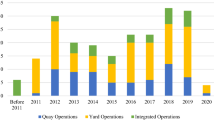Abstract
Fast handling of vessels is one of the most important goals in container terminal operations planning. In recent studies, quay crane double cycling has been investigated to accelerate the service of vessels. In our paper, we show that the service process can be further accelerated by changing the treatment of so-called reshuffle containers. Reshuffle containers have to be removed from their position in the vessel only to gain access to containers stacked below them. Our approach enables to reposition reshuffle containers directly within the bay of a vessel, referred to as internal reshuffles, instead of temporarily unloading them. A mathematical problem formulation and a heuristic solution method, namely a greedy randomized adaptive search procedure, are provided for planning crane operations under internal reshuffles. Computational tests prove that the consideration of internal reshuffles leads to a further shortening of vessel handling times compared to a sole application of crane double cycling.
Similar content being viewed by others
References
Ambrosino D, Sciomachen A (2003) Impact of yard organisation on the master bay planning problem. Marit Econ Logist 5(3): 285–300
Ambrosino D, Sciomachen A, Tanfani E (2004) Stowing a containership: the master bay plan problem. Transp Res A 38(2): 81–99
Avriel M, Penn M (1993) Exact and approximate solutions of the container ship stowage problem. Comput Ind Eng 25(1–4): 271–274
Bendall HB, Stent AF (1996) Hatchcoverless container ships: productivity gains from a new technology. Marit Policy Manage 23(2): 187–199
Bierwirth C, Meisel F (2009) A fast heuristic for quay crane scheduling with interference constraints. J Sched 12(4): 345–360
Bierwirth C, Meisel F (2010) A survey of berth allocation and quay crane scheduling problems in container terminals. Eur J Oper Res 202(3): 615–627
Caserta M, Schwarze S, Voß S (2008) A mathematical formulation for the blocks relocation problem. Working paper, University of Hamburg
Chu C-Y, Huang W-C (2002) Aggregates cranes handling capacity of container terminals: the port of kaohsiung. Marit Policy Manage 29(4): 341–350
Daganzo CF (1989) The crane scheduling problem. Transp Res B 23(3): 159–175
Goodchild AV, Daganzo CF (2006) Double-cycling strategies for container ships and their effect on ship loading and unloading operations. Transp Sci 40(4): 473–483
Goodchild AV, Daganzo CF (2007) Crane double cycling in container ports: planning methods and evaluation. Transp Res B 41(8): 875–891
Imai A, Nishimura E, Papadimitriou S, Sasaki K (2002) The containership loading problem. Int J Marit Econ 4(2): 126–148
Imai A, Sasaki K, Nishimura E, Papadimitriou S (2006) Multi-objective simultaneous stowage and load planning for a container ship with container rehandle in yard stacks. Eur J Oper Res 171(2): 373–389
Johnson SM (1954) Optimal two- and three-stage production schedules with setup times. Nav Res Logist Q 1(1): 61–68
Kang J-G, Kim Y-D (2002) Stowage planning in maritime container transportation. J Oper Res Soc 53(4): 415–426
Kim KH, Hong G-P (2006) A heuristic rule for relocating blocks. Comput Oper Res 33(4): 940–954
Kim KH, Kang JS, Ryu KR (2004) A beam search algorithm for the load sequencing of outbound containers in port container terminals. OR Spectr 26(1): 93–116
Kim KH, Park YM (2004) A crane scheduling method for port container terminals. Eur J Oper Res 156(3): 752–768
Lim A, Rodrigues B, Xu Z (2007) A m-parallel crane scheduling problem with a non-crossing constraint. Nav Res Logist 54(2): 115–127
Liu J, Wan Y-W, Wang L (2006) Quay crane scheduling at container terminals to minimize the maximum relative tardiness of vessel departures. Nav Res Logist 53(1): 60–74
Moccia L, Cordeau J-F, Gaudioso M, Laporte G (2006) A branch-and-cut algorithm for the quay crane scheduling problem in a container terminal. Nav Res Logist 53(1): 45–59
Resende MGC, Ribeiro CC (2003) Greedy randomized adaptive search procedures. In: Glover F, Kochenberger G (eds) Handbook of Metaheuristics. Kluwer, Dordrecht, pp 219–249
Sammarra M, Cordeau J-F, Laporte G, Monaco MF (2007) A tabu search heuristic for the quay crane scheduling problem. J Sched 10(4–5): 327–336
Stahlbock R, Voß S (2008) Operations research at container terminals: a literature update. OR Spectr 30(1): 1–52
Zhang H, Kim KH (2009) Maximizing the number of dual-cycle operations of quay cranes in container terminals. Comput Indust Eng 56(3): 979–992
Zhu Y, Lim A (2006) Crane scheduling with non-crossing constraint. J Oper Res Soc 57(12): 1464–1471
Author information
Authors and Affiliations
Corresponding author
Rights and permissions
About this article
Cite this article
Meisel, F., Wichmann, M. Container sequencing for quay cranes with internal reshuffles. OR Spectrum 32, 569–591 (2010). https://doi.org/10.1007/s00291-009-0191-6
Published:
Issue Date:
DOI: https://doi.org/10.1007/s00291-009-0191-6




